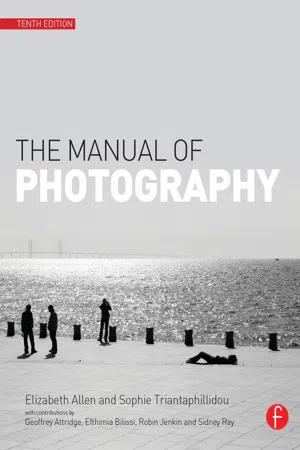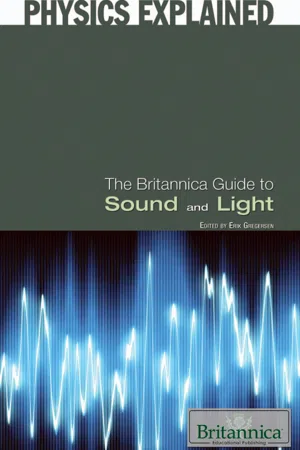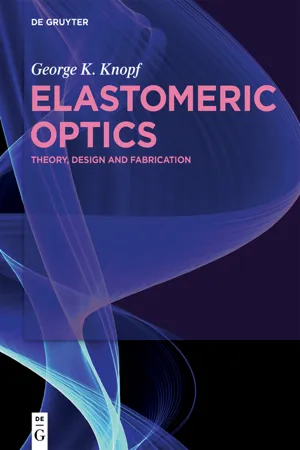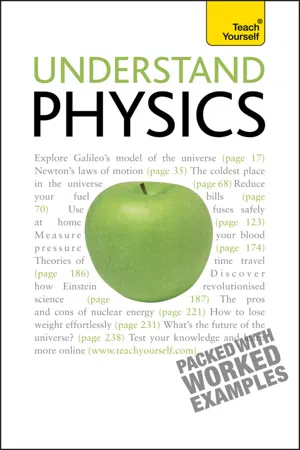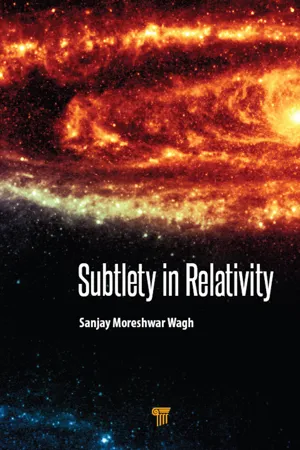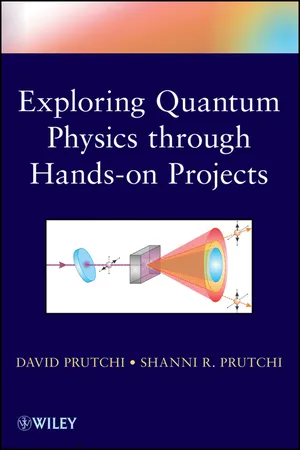Physics
Path of Light
The "Path of Light" refers to the trajectory followed by light as it travels through a medium or space. In physics, this concept is fundamental to understanding the behavior of light, including phenomena such as reflection, refraction, and dispersion. The path of light can be described using principles of optics and wave theory.
Written by Perlego with AI-assistance
Related key terms
Related key terms
1 of 4
Related key terms
1 of 3
10 Key excerpts on "Path of Light"
- eBook - ePub
- Elizabeth Allen, Sophie Triantaphillidou(Authors)
- 2012(Publication Date)
- Routledge(Publisher)
The study of the behaviour and properties of light and the way in which it interacts with matter is termed optics. The various areas of optics may be broadly classed according to the different models used to explain the particular properties.Table 2.1 Radiometric definitions and unitsTable 2.2 Photometric definitions and unitsPhysical or wave optics models the propagation of light through an optical system as a complex wavefront. When a wavefront reaches an obstacle it may change direction, resulting in interference between different wavefronts.Geometrical optics discounts the wave nature of light and studies its propagation in terms of rays. The path of any single point on the wavefront referred to above is a straight line with direction perpendicular to the wavefront. Hence we say that light travels in straight lines, in rays. The concept of light rays is helpful in studying the formation of an image by a lens.Both are branches of classical optics and use approximations to model the behaviour of light. Physical optics successfully explains the diffraction, interference and polarization of light. Geometrical optics models the path of a ray of light as it moves through an optical system and may be used to describe reflection and refraction, which form the basis of imaging by lenses and are fully described in Chapter 10 .Quantum optics considers radiation in terms of quanta of energy. The effects of this are only evident at an atomic or subatomic level with the emission or absorption of light energy by matter, for example by a photographic emulsion or silicon in a digital sensor.Aspects of wave theory, physical optics and quantum optics are covered in more detail in the remainder of this chapter.WAVE THEORY
Many of the properties of light can be described by the fact that it takes the form of a wave, i.e. a disturbance that propagates in space. The family of waves that propagate in the same fashion as light waves are termed electromagnetic waves; therefore, the wave nature of light is described here in the context of electromagnetic theory. Where sound waves propagate in a mechanical fashion through matter – for example, air, rock and water – electromagnetic waves are self-propagating, waves travelling freely in empty space (the so-called vacuum) with a maximum velocity, c, of approximately 2.998 × 108 - eBook - ePub
- Andrew Rex(Author)
- 2014(Publication Date)
- CRC Press(Publisher)
8 m/s, follows directly from electromagnetic theory. Modeling light as a wave explains phenomena such as diffraction and interference, which we’ll address later in this chapter.You’ve also seen that the electromagnetic wave alone is insufficient to describe how light behaves (Chapter 4). Rather, light consists of small quanta of energy called photons. In carefully designed experiments, individual photons can be detected and counted. A complete view of light includes both waves and particle-like photons, and we are left to contemplate the resulting wave–particle duality.What Are Ray Optics and Wave Optics?
The dual nature of light suggests two ways to approach the study of optics. As the name suggests, ray optics (also called geometrical optics) assumes that light travels in a straight line until it encounters an object or change of medium, at which point the ray’s change of direction can be predicted using systematic rules. For example, a ray of light (say, from your flashlight) that strikes a plane mirror reflects in a predictable way. The bending of light rays entering your eye focuses those rays on your retina and allows you to see. Wave optics (also called physical optics) is required whenever light exhibits interference effects, diffraction, or polarization. We’ll explain all those effects in this chapter, after first considering some of the effects of ray optics—principally, reflection and refraction.What Is the Law of Reflection?
The law of reflection says that a ray of light that strikes a mirror reflects at an angle equal to the angle made by the incident ray, as shown in Figure 5.1 . Reflections from any kind of mirrored surface follow from this simple rule. Notice that the angles of incidence and reflection are always measured with respect to a line called the normal, - eBook - ePub
- Britannica Educational Publishing, Erik Gregersen(Authors)
- 2010(Publication Date)
- Britannica Educational Publishing(Publisher)
Newton’s corpuscular model survived into the early years of the 19th century, at which time evidence for the wave nature of light became overwhelming. Theoretical and experimental work in the mid to late 19th century convincingly established light as an electromagnetic wave, and the issue seemed to be resolved by 1900. With the arrival of quantum mechanics in the early decades of the 20th century, however, the controversy over the nature of light resurfaced. As will be seen in the following sections, this scientific conflict between particle and wave models of light permeates the history of the subject.GEOMETRICAL OPTICS: LIGHT AS RAYS
A detailed understanding of the nature of light was not needed for the development, beginning in the 1600s, of a practical science of optics and optical instrument design. Rather, a set of empirical rules describing the behaviour of light as it traverses transparent materials and reflects off smooth surfaces was adequate to support practical advances in optics. Known collectively today as geometrical optics, the rules constitute an extremely useful, though very approximate, model of light. Their primary applications are the analysis of optical systems—cameras, microscopes, telescopes—and the explanation of simple optical phenomena in nature.LIGHT RAYSThe basic element in geometrical optics is the light ray, a hypothetical construct that indicates the direction of the propagation of light at any point in space. The origin of this concept dates back to early speculations regarding the nature of light. By the 17th century the Pythagorean notion of visual rays had long been abandoned, but the observation that light travels in straight lines led naturally to the development of the ray concept. It is easy to imagine representing a narrow beam of light by a collection of parallel arrows—a bundle of rays. As the beam of light moves from one medium to another, reflects off surfaces, disperses, or comes to a focus, the bundle of rays traces the beam’s progress in a simple geometrical manner.Geometrical optics consists of a set of rules that determine the paths followed by light rays. In any uniform medium the rays travel in straight lines. The light emitted by a small localized source is represented by a collection of rays pointing radially outward from an idealized “point source.” A collection of parallel rays is used to represent light flowing with uniform intensity through space; examples include the light from a distant star and the light from a laser. The formation of a sharp shadow when an object is illuminated by a parallel beam of light is easily explained by tracing the paths of the rays that are not blocked by the object. - eBook - ePub
Laser Safety
Tools and Training, Second Edition
- Ken Barat, Ken Barat(Authors)
- 2017(Publication Date)
- CRC Press(Publisher)
To set the stage for the following treatment of geometrical optics, it is helpful to provide an outline of the more comprehensive modern understanding of the nature of light. Concepts such as the relation between wavelength and color are frequently referred to in geometrical optics but are best introduced as part of the wave theory. Furthermore, in some situations, such as the behavior of very-high-quality optical systems or the propagation of laser beams, the geometrical theory is not completely adequate, and some concepts from the wave theory are required. Finally, some of the common optical components that are discussed in the final section can only be understood by referring to the quantum theory of light.Because vision is so central to our perception of the world, it is not surprising that people since the beginning of recorded history have tried to understand the nature of light and vision. The concept of a line of sight and the observation of shadows have from ancient times suggested that light is something that travels in straight lines. We can introduce the somewhat abstract concept of a ray of light based on this as shown in Figure 6.1 . A ray is a single geometric line of light that originates at some light source, like a point on the candle in the figure, and proceeds until it is stopped at some object. The candle emits rays of light in all directions and from each part of the flame. The rays can be different colors. Some rays from the candle are yellow; others are blue or orange. In this view of the nature of light, the reason we can see the candle is that some of the rays from the candle travel to our eyes. This seemingly simple concept that we perceive visual objects only when rays of light enter our eyes can be very helpful in understanding optical phenomena.This concept of light as some form of energy traveling in straight lines originating at a source explains many observations regarding the behavior of light, but early in the eighteenth century scientists began to discover cases in which the behavior of light was more complicated. In the phenomenon called interference , when two light rays strike the same point the amount of light energy at the point can be more or less than the total energy in the two rays. Another phenomenon called diffraction - eBook - ePub
- Cesar A. Sciammarella, Federico M. Sciammarella(Authors)
- 2012(Publication Date)
- Wiley(Publisher)
We have to return to the wave-particle duality principle. A photon is the elementary particle, associated with the electromagnetic field and it can be thought of as the basic “unit” of light with regards to visible radiation. However in general a photon is associated with all other forms of electromagnetic radiation. It is also a force carrier for electromagnetic radiation. The effects of this force are observed both at the microscopic and macroscopic levels. The photon is a mass-less particle, meaning that it does not have mass at rest. The photon has a momentum defined by(6.5)In classical mechanics momentum is the product of the mass of a particle and the velocity of the particle. The photon as a quantum particle has another property that is of fundamental importance, “spin”, envision the photon as a small sphere that rotates around its axis. The spin is related to the state of polarization of the photon. In many areas of optics we can set aside the particle nature of light. However in some cases it is necessary to resort to the particulate nature of light. For example when we are dealing with the interaction of light with matter one has to bring back the concept of light as a particle; this is the case of the photoelectric effect. Many developments in the field of Optics in the second half of the twentieth century that cannot be explained by classical Optics arguments need to utilize the particle nature of the photon. For example it is possible to produce light interference, a typical phenomenon of the wave nature of light by detecting one photon in time. To explain this phenomenon one has to utilize the quantum theory of light since it has no explanation in Classical Optics.6.3 The Electromagnetic Theory of LightWe have introduced the main variables that help describe the light propagation phenomenon; we now must analyze the mathematical structure that supports these basic notions. The mathematical support is given by the Maxwell equations. The fundamental idea introduced by Maxwell is the classical field theory. A physical field is defined by the fact that at each point in space at a given time (usually in a continuous manner), can be defined by a physical quantity. In the case of electromagnetic fields, two vectors are present at each point in space, the electrical field E and the magnetic field B . As such, they are often written as E (x, y, x, t), electric field and B - eBook - ePub
Elastomeric Optics
Theory, Design, and Fabrication
- George K. Knopf(Author)
- 2022(Publication Date)
- De Gruyter(Publisher)
2 Light and Optical Waveguides2.1 Light and the Electromagnetic Spectrum
Our understanding about the nature of light has continuously evolved throughout written history [1 ]. Several thousand years ago the ancient Greeks speculated that sources of natural light, such as the Sun or a candle flame, emit tiny particles called corpuscles. This interpretation of light was an accepted truth until the seventeenth century when the Dutch astronomer Christian Huygens (1629–1695) proposed a revolutionary idea. Huygens hypothesized that light was generated by moving waves emanating in all directions from the source through an all-pervasive medium called ether. To support his novel hypothesis Huygens would experimentally show that the notion of light waves could explain commonly observed optical phenomenon such as mirror reflections and the light refraction through a transparent medium. However, Huygens’ theory of light waves was not universally accepted by all his contemporaries in the scientific community. One of the most vocal opponents of this theory was Sir Isaac Newton who advocated for the particle theory of light in 1704 [2 ]. According to Newton, light behaves as a stream of very small particles that emanate from the source. These streams of particles, or rays, travel in a straight line. The opposing interpretations of light would be debated vigorously amongst the scientific community until 1801 when Thomas Young’s double-slit experiment demonstrated that light rays would indeed interfere with each other like waves.The scientific relationship between light and electromagnetism was established in 1845 by Michael Faraday. Faraday discovered that for a transparent dielectric material the plane of polarization of a linearly polarized light is rotated when the light rays travel along the direction of the magnetic field [3 , 4 ]. James Maxwell would further explain the behaviour of electric and magnetic fields associated with light waves in 1873 and he would go on to hypothesize that these self-propagating electromagnetic waves would all travel at a constant speed [5 ]. In other words, all electromagnetic radiation including visible light is the result of oscillating electric charges which exhibit wavelike properties at specific wavelengths λ . The spectrum of electromagnetic radiation is shown in Figure 2.1 - eBook - ePub
- Jeremy Sanderson(Author)
- 2019(Publication Date)
- Wiley(Publisher)
2 LightOutline
2.1 Introduction- The importance of light
2.2 The Nature of Light- Newton splitting sunlight with a prism
- Newton’s view of the corpuscular nature of light
- Huygens, Young and Fresnel’s view of the wave nature of light
2.3 The Nature of Waves- Periodic harmonic motion
- Mechanical and electromagnetic waves
- Characteristics of waves
2.4 Wave-Particle Duality- Maxwell’s equations of electromagnetic waves
- Planck and Einstein’s introduction of energy quanta
- The photoelectric effect
- The wave-particle model of light
- The origin of light
2.5 The Visible Light Spectrum- The spectral colours
- Newton’s classification of the visible spectrum
2.6 Important Properties of Light- Monochromaticity
- Coherence
- Collimation
- Polarisation
2.7 Interaction of Light with Matter- Absorption
- Reflection and refraction
- Scattering and diffraction
- Phase change
- Polarisation
- Fluorescence
2.8 Reflection of Light- Reflection of light
- Specular and diffuse reflection
2.9 Refraction of Light- Basis of refraction
- Refraction as a change in velocity
- Snell’s law
- Fermat’s principle of least time
- Homogeneous immersion
2.10 Total Internal Reflection- Basis of total internal reflection
2.11 Dispersion- Basis of dispersion
2.12 Refraction and the Action of Lenses- Lenses as a series of prisms
- Principal focal points and focal planes
2.13 Chapter Summary- 24 points
Key ReadingReferencesFurther ReadingInternet Resources2.1 Introduction
Having emphasised in Chapter 1 that all images are seen by the eye, this chapter considers the start of the imaging process: light. We shall discuss what light is and how it interacts with matter. We shall consider how the velocity of light is altered by materials denser than air and how rays of light are bent or refracted.Light is so central to our perception that for much of the time we are unaware of it and take it for granted, except perhaps when viewing a gorgeous sunset or glimpsing crepuscular rays behind clouds. Although light surrounds us and is essential for life, it is anything but ordinary. As one popular science writer has put it: ‘Light, the universal metaphor for understanding and revelation, is astonishingly opaque’ (Brooks, 2012). The Greeks were aware of the importance of light, referring to dying as ‘losing the light’. Yet it is only in the last 200 years that humankind has begun to understand light’s unique properties. Indeed, Benjamin Franklin remarked in a letter discussing science to a colleague, written in April 1752, ‘I must own that I am much in the Dark about Light… - eBook - ePub
- Jim Breithaupt(Author)
- 2010(Publication Date)
- Teach Yourself(Publisher)
Light has a dual nature: it is wave-like in interference experiments and particle-like in photoelectricity. This dual nature of light was to provide a path in a direction completely unexpected by physicists at the end of the nineteenth century. Within two decades, the classical laws of physics had given way as a revolution swept through physics and our perception of matter and energy. We will meet the new physics, known as quantum physics, in Chapter 10. Electromagnetic waves The spectrum of electromagnetic waves in order of increasing wavelength: gamma rays and X-rays; ultraviolet radiation; visible light; infrared light; microwaves; radio waves. Visible light covers the wavelength range from about 0.0004 mm for violet light to about 0.0007 mm for infrared light. All electromagnetic waves travel in a vacuum at a speed of 300 000 kilometres per second. Photon theory : Light consists of photons which are wave packets of electromagnetic radiation - eBook - ePub
- Sanjay Moreshwar Wagh(Author)
- 2017(Publication Date)
- Jenny Stanford Publishing(Publisher)
Part IDEVELOPMENT OF PHYSICAL CONCEPTSPassage contains an image Chapter 1 The Light Quantum In this chapter, we consider the development of ideas about the kind of physical body light is and lead up to the concept of a light quantum. We begin with the wave theory of light. 1.1 Wave Theory of Light
During some era, sound got established as a propagating sequence of compression and rarefaction of matter, a wavy disturbance of static pressure, a pressure wave propagating in a material, such as air. The motion of material particle is in the direction of the propagation of the (sound) wave, and such waves are called longitudinal waves now.René Descartes (1596–1664) had assumed light to be like a sound wave, that light is a (longitudinal) pressure wave propagating in a subtle medium that he called “ether.”Originally, this Greek word, ether, had meant the blue sky or the upper air as compared to air at the sea level, and later, it only meant that which occupied the great celestial sphere. Descartes brought ether into science by postulating that it has mechanical properties.He had assumed that particles of ether are in motion continually. For him, the motion of a single particle of ether involved motion of them all, as they come into contact with each other in a chain, forming a vortex. His theory of vortices had formed his picture of the cosmos.Descartes had been the originator of the mechanistic view of the world, which imagined that the (inanimate) world works as an automatic mechanism, that is, every physical phenomenon is understandable by a suitable mechanical model of the involved bodies.However, Descartes’s assumption that light is a longitudinal wave of static pressure propagating within ether ran contrary to some properties of light, discovered subsequently by others. *A law of refraction of light was experimentally discovered by Willebrord Snell (1591–1676), professor of mathematics at Leyden, Holland. Descartes used Snell’s law but did not acknowledge Snell for it. - David Prutchi(Author)
- 2012(Publication Date)
- Wiley(Publisher)
1LIGHT AS A WAVE
Before we get into quantum physics, let’s understand the classical view of light. As early as 100 C.E., Ptolemy—a Roman citizen of Egypt—studied the properties of light, including reflection, refraction, and color. His work is considered the foundation of the field of optics. Ptolemy was intrigued by the way that light bends as it passes from air into water. Just drop a pencil into a glass of water and see for yourself!As shown in Figure 1a , the pencil half under the water looks bent: light from the submerged part of the stick changes direction as it reaches the surface, creating the illusion of the bent stick. This effect is known as refraction, and the angle at which the light bends depends on a property of a material known as its refractive index.Figure 1 Refraction of light: (a) A pencil dipped in water appears distorted because refraction causes light to bend when it passes from one substance into another, in this case from air to water. (b) A laser pointer clearly demonstrates Snell’s law of diffraction.In the 1600s, Dutch mathematician Willebrord Snellius figured out that the degree of refraction depends on the ratio of the two materials’ different refractive indices. Most materials have a refractive index greater than 1, which means that as light enters the material from air, the angle of the ray in the material will become closer to perpendicular to the surface than it was before it entered. This is known as Snell’s Law, which states that the ratio of the sines of the angles of incidence and refraction (θ1 , θ 2 ) is equal to the inverse ratio of the indices of refraction (n1 n2 ):Try it out yourself with a small laser pointer! As shown in Figure 1b
Index pages curate the most relevant extracts from our library of academic textbooks. They’ve been created using an in-house natural language model (NLM), each adding context and meaning to key research topics.
Explore more topic indexes
Explore more topic indexes
1 of 6
Explore more topic indexes
1 of 4
